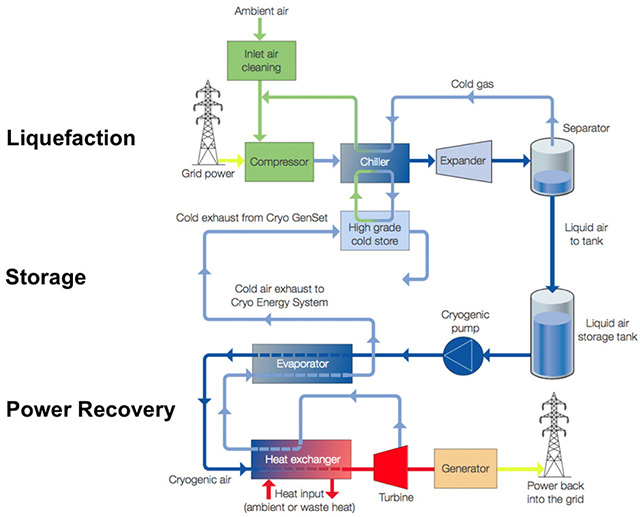Cryogenic Energy Storage
Engines with cool exhaust.
Background
Cryogenic energy storage is a novel method of storing grid electricity. The idea is that off-peak or low-cost electricity is used to liquefy air (by way of a compressor, cooler and then expander), that is then stored in an energy dense cold liquid form. When electricity is required the cold liquid air is pumped to increase its pressure, super-heated in a heat exchanger using either ambient or low-grade waste heat and then expanded through a turbine generating useful electricity. This process is illustrated in the Figure below.

Figure: Schematic diagram of a CES system.
Characteristics
The energy density for liquid air is around 100-200 Wh/kg and in a recent report on CES by the Centre for Low Carbon Futures in the UK, the cost of liquid air was estimated between $200-530/kWh (Centre for low Carbon Futures and the Liquid Air Energy Network, 2013). Proponents of CES suggest that some of the main advantages of CES are the ability to use existing gas infrastructure, its high cycling ability, the fact that it has no geographical constraints and that CES is a mechanical system which isn’t constructed with any exotic materials, unlike batteries, capacitors etc. It should be suitable for grid energy storage on a medium to large scale, for back-up generation, renewable integration and energy management.
There is also interest in liquid air as an ‘energy vector’ which could be used in smaller scale applications in zero emissions vehicles. Mobile refrigeration units are especially interesting as a liquid air engine could provide power and cooling.
At present the proven efficiency of CES is low in the prototype devices, however, Highview Power Storage expect that their second generation device should achieve around 60% efficiency utilising the waste heat from a ‘waste to power’ thermal generation plant. Much of the expertise in CES is in the UK with Highview Power Storage and a new Centre for Cryogenic Energy Storage at the University of Birmingham working with the Chinese Academy of Sciences. There has also been some research at the Universities of Washington and North Texas. CES is still a technology in the demonstration phase rather than being commercial though it is expected to see rapid development in the next few years. The table below illustrates some of the anticipated characteristics of CES.
Table of characteristics
| Typical Capacity | Typical Power | Efficiency (%) | Storage Duration | $/kWh | $/kW | Lifespan | Cycling capacity | Comments |
| Up to 15MWh (anticipated up to 200MWh) | 100kW - 5MW (anticipated up to 50MW) | Presently low, anticipated in excess of 60 [1] | mins - days | 200-530 [1] | - | 20-40 years | High | Demonstration phase |
Table: CES characteristics
References
[1] Centre for low Carbon Futures and the Liquid Air Energy Network, 2013